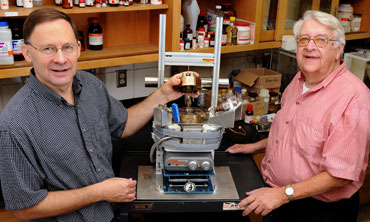Iowa State University researchers have found a new method to make important chemicals such as ethylene glycol and propylene glycol from biomass instead of petroleum sources.

Researcher Walter Trahanovsky, professor of chemistry at Iowa State University, was looking for a way to make sugar derivatives from cellulose (cellulose) and other biomass-derived materials using high-temperature chemistry. To this end, he and his research group examined the reactions of cellulosic materials in solutions, under conditions of high temperature and pressure.
They examined their reaction products using NMR spectroscopy. Early experiments showed that the expected sugar derivatives are indeed formed. However, further research clearly revealed significant amounts of ethylene glycol and propylene glycol. "It was a real surprise," said the researcher. "We did not expect these products, so we never looked for them. But they were always there."
Uses of ethylene glycol include automotive antifreeze, polyester fibers and plastic bottles. Propylene glycol has many uses, including food additives, a solvent in the pharmaceutical industry, moisturizers in cosmetics and as a coolant in liquid cooling systems.
Conversion of biomass to fuels and other chemicals requires the use of strong acids or other expensive active compounds. In these processes, chemical waste is also created, which must be collected and disposed of due to safety considerations.
The researchers claim that they have found a method that is simpler and still more effective and better for the environment. "There is a lot of potential in our method," said the lead researcher. It is not a wild dream to believe that our method can be developed into a practical process."
The biomass conversion process is based on the chemistry of supercritical fluids - liquids heated under pressure to the point where their liquid and gaseous forms merge. In this case, explains the lead researcher, the main results are obtaining significant amounts of ethylene glycol, propylene glycol and other chemicals that have a low molecular weight. In addition, the researcher notes, the process also produces glycosides and the substance levoglucosan that can be converted into glucose which is used to produce ethanol or in other uses.
All these materials are obtained without the use of expensive reagents such as acids, enzymes, catalysts or hydrogen gas, adds the researcher. The process occurred even when the biomass contained impurities. The intellectual property company of the university submitted an application for the protection of the method by patent.

2 תגובות
The future is in biomass.
It is interesting to know how many kg of biomass are thrown away from each kg of clean wheat. And what do we do with all this endless organic waste from industrial and domestic sewage? Smart people know how to make gold and this garbage. And the gold will turn into diamonds if renewable energy is used to utilize all this goodness.
Happy New Year,
Ami Bachar
It is very interesting and also good to hear about achievements in public universities in the US and not just in private.